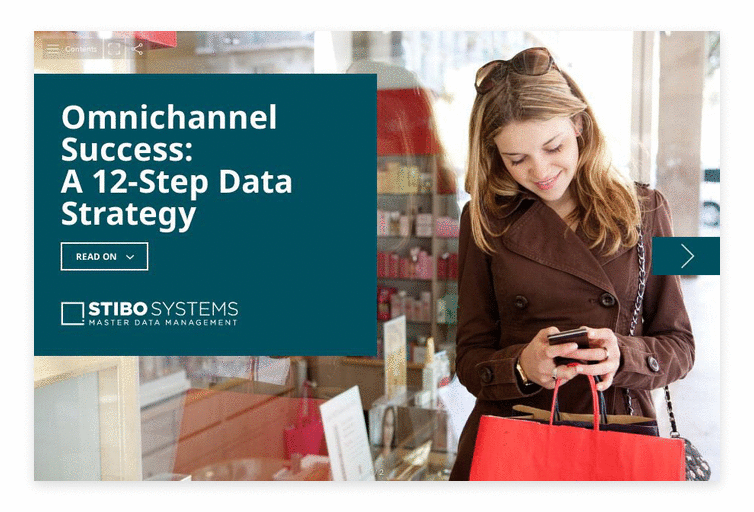In today's fast-paced retail landscape, businesses face the challenge of meeting customer expectations across multiple channels. With the rise of e-commerce, mobile shopping and social media, retailers must decide how to effectively engage with customers and provide seamless shopping experiences. This brings us to the debate between two prominent strategies: omnichannel and multichannel retailing.
Understanding the key differences between omnichannel and multichannel is crucial for businesses seeking to enhance their customer experience and drive growth. While the terms are often used interchangeably, they represent distinct approaches that can greatly impact your business. In this blog post, we will delve into the nuances of both strategies and explore how you can choose the right one for your business.

What is omnichannel?
Omnichannel refers to a business approach that aims to provide a seamless and integrated customer experience across multiple channels and touchpoints. It involves combining various communication and distribution channels, such as online platforms, physical stores, mobile apps, social media and customer service centers, into a unified and cohesive system.
The goal of an omnichannel strategy is to enable customers to interact with a company or brand through their preferred channels and have a consistent experience throughout their journey, regardless of the channels they use. It emphasizes the importance of delivering a cohesive message, consistent branding and synchronized customer interactions across different touchpoints.
With an omnichannel approach, customers can browse products online, make purchases through a mobile app, visit a physical store for pickup or returns and engage with customer service representatives through various channels. The key aspect is that the customer can transition between channels seamlessly, without any disruptions or inconsistencies.
By implementing an omnichannel strategy, businesses can enhance customer satisfaction, improve engagement and loyalty, increase sales and gain a competitive edge in the market. It recognizes the changing behavior and preferences of modern consumers, who expect a convenient, personalized and interconnected experience across multiple channels.
The backbone of unified product experiences
Delivering competitive customer experiences begins with trustworthy product data. The key to a unified product experience is seamlessly connecting data across all channels. This integration empowers smarter decisions and fosters stronger engagement at every touchpoint.
How does omnichannel retail work?
Omnichannel retail is a strategy that integrates various channels and touchpoints to provide a seamless and cohesive shopping experience for customers. Here is how it typically works:
-
Channel integration
Omnichannel retail begins with integrating different channels, such as physical stores, e-commerce websites, mobile apps, social media platforms and more. These channels should be connected and synchronized to enable a smooth transition for customers as they move between them.
-
Unified inventory management
A crucial aspect of omnichannel retail is having a centralized inventory management system. This system tracks and syncs inventory levels across all channels in real-time. It ensures that customers can access accurate product information, availability and pricing, regardless of the channel they are using.
-
Consistent branding and messaging
Maintaining consistent branding and messaging across channels is essential. Customers should have a cohesive experience and recognize the brand, regardless of the channel they engage with. This consistency helps build trust and reinforces brand identity.
-
Cross-channel customer experience
Omnichannel retail aims to provide a seamless customer experience across channels. For example, customers may research products online, visit a physical store to see them in person, make the purchase online and choose to pick up the item in-store. Alternatively, they may initiate a purchase on a mobile app and complete it on a desktop computer. The key is to enable customers to switch channels effortlessly and have a consistent experience throughout their journey.
-
Data and personalization
Omnichannel retail leverages customer data to deliver personalized experiences. By collecting and analyzing data from various channels, businesses can gain insights into customer preferences, behaviors and purchase history. This data can be used to offer personalized recommendations, targeted promotions and tailored communication across channels.
-
Seamless customer service
Omnichannel retail extends to customer service as well. Customers should be able to receive support and assistance through multiple channels, such as phone, email, live chat, social media and in-person interactions. The customer service team should have access to relevant customer data and be able to provide consistent and personalized assistance, regardless of the channel used.
The ultimate goal of omnichannel retail is to provide a convenient, integrated, and personalized shopping experience that meets customers' expectations and preferences. By combining the strengths of various channels and delivering a seamless experience, businesses can enhance customer satisfaction, drive sales and build long-term customer loyalty.
CHECKLIST
Omnichannel Success: A 12-Step Data Strategy

What is multichannel?
Multichannel refers to a business approach that involves utilizing multiple channels to reach and interact with customers. It involves having a presence across various communication and distribution channels, such as physical stores, websites, mobile apps, social media platforms, email and phone.
Unlike an omnichannel approach, which aims for a seamless and integrated customer experience across channels, a multichannel strategy typically treats each channel as a separate entity with its own objectives and operations. In a multichannel approach, customers may have different experiences and encounter inconsistencies when transitioning between channels.
For example, a retailer using a multichannel strategy may have a physical store where customers can make purchases, a website for online shopping and a social media presence for promotional activities. While each channel serves a purpose and may offer unique benefits, they may not be fully integrated or provide a consistent experience.
A multichannel approach allows businesses to cater to different customer preferences and capture a wider audience by being present on various platforms. However, it requires careful coordination and management to ensure that each channel operates effectively and delivers a positive customer experience.
It is worth noting that the terms "multichannel" and "omnichannel" are sometimes used interchangeably, but they do have distinct differences in terms of the level of integration and consistency provided across channels.
How does multichannel retail work?
Multichannel retail refers to a strategy where a retailer operates through multiple channels to reach and engage with customers. Here is how multichannel retail typically works:
-
Channel presence
A retailer employing a multichannel approach establishes a presence across different channels, such as physical stores, e-commerce websites, mobile apps, social media platforms, catalog sales or third-party marketplaces. Each channel serves as a separate entity with its own operations and objectives.
-
Channel-specific operations
Each channel is managed independently, focusing on its unique features and capabilities. For example, physical stores handle in-person sales, product displays and customer service, while the e-commerce website facilitates online purchases and order fulfillment. The retailer may also have a social media team managing engagement and promotion on social platforms.
-
Channel-specific inventory management
In multichannel retail, inventory management may be specific to each channel. There might be separate inventories for physical stores and online sales. This approach can lead to challenges in maintaining accurate stock information across channels.
-
Channel-specific customer experience
Customers may have different experiences depending on the channel they choose. For instance, in-store shoppers can physically browse and interact with products, while online shoppers rely on product descriptions, images and reviews. The customer experience may vary in terms of pricing, promotions and available features across channels.
-
Cross-channel coordination
While multichannel retail treats each channel as distinct, there may still be efforts to coordinate activities across channels. For example, the retailer may promote online-exclusive deals through social media or email campaigns, or provide options for in-store pickup of online orders.
-
Customer channel choice
Customers have the freedom to choose the channel that suits their preferences and needs. They may decide to make purchases in-store, online or through other available channels. However, there may not always be a seamless transition between channels and customers may encounter inconsistencies in pricing, promotions or product availability.
-
Customer service across channels
Multichannel retailers provide customer service through various channels, such as phone, email or in-person assistance. However, the level of integration and consistency in customer service experiences may vary across channels.
In summary, multichannel retail involves operating through multiple channels, each with its own independent operations and objectives. While customers have the flexibility to choose their preferred channel, there may be variations in pricing, promotions and customer experiences across different channels.
WHITE PAPER
Strategies for a Superior Omnichannel Experience
How to leverage your data to win
customer loyalty in retail.

Omnichannel vs. multichannel – what is the difference?
Omnichannel and multichannel are two different approaches to retailing and they differ in terms of integration, customer experience and overall strategy. Here is a breakdown of the key differences between omnichannel and multichannel:
1. Integration
Omnichannel retail emphasizes integration and coordination across channels, aiming for a seamless and consistent customer experience as customers transition between channels. Multichannel retail treats each channel as separate entities, with limited integration between them.
2. Customer experience
Omnichannel retail focuses on delivering a cohesive, unified, and personalized customer experience across all channels. It aims to provide a seamless and consistent experience, regardless of the channel used by customers. Multichannel retail offers different customer experiences across channels, with less emphasis on integration and consistency.
3. Channel coordination
In omnichannel retail, there is coordination and synchronization of activities across channels. Channels are interconnected, and customers can start and continue their shopping journey across different touchpoints. In multichannel retail, channels operate more independently, with less coordination and interaction between them.
4. Inventory management
Omnichannel retail typically employs a centralized inventory management system that tracks and synchronizes inventory levels across all channels. This ensures accurate and real-time product availability information. Multichannel retail may have separate inventory systems for each channel, leading to potential inconsistencies in inventory data.
5. Branding and messaging
Omnichannel retail maintains consistent branding and messaging across all channels to reinforce brand identity and recognition. Multichannel retail may have variations in branding and messaging across different channels, potentially leading to a less cohesive brand image.
6. Customer service
Omnichannel retail extends a seamless customer service experience across channels, with customer service representatives having access to relevant customer information and interactions across all touchpoints. Multichannel retail may provide customer service through multiple channels but without the same level of integration and consistency.
Overall, the key difference between omnichannel and multichannel retail lies in the level of integration, consistency, and customer experience. Omnichannel retail strives for a unified and seamless customer journey across channels, while multichannel retail focuses on maintaining a presence across various channels without the same level of integration and coordination.
How MediaMarktSaturn leverages MDM for data-driven growth
MediaMarktSaturn is leveraging Stibo Systems Platform to streamline business processes. With a single source of truth for their data, they can power all digital touchpoints and make informed, data-driven decisions.
How to choose the right strategy for your business
Choosing the right strategy, whether omnichannel or multichannel, depends on several factors specific to your business and your customers. Here are some considerations to help you make an informed decision:
1. Customer preferences
Understand your target audience and their preferred channels of engagement. Research their behaviors, expectations, and preferences regarding shopping experiences. If your customers are increasingly using multiple channels and expect a seamless experience, an omnichannel approach may be more suitable. If they have specific channel preferences and do not necessarily require a fully integrated experience, a multichannel strategy might suffice.
2. Business resources
Consider your available resources, including financial, technological and operational capabilities. Implementing an omnichannel strategy often requires more significant investments in infrastructure, integration systems and data management. Evaluate whether your business has the resources and capabilities to support a comprehensive omnichannel approach. If not, a multichannel strategy may be a more practical choice.
3. Industry and competition
Analyze your industry and competitive landscape. Research how your competitors are approaching customer engagement and determine if they have successfully implemented omnichannel or multichannel strategies. Assess the impact these strategies have had on their market position and customer satisfaction. This analysis can help you identify the best approach for your business.
4. Channel synergy
Consider the synergies that exist between your channels. Evaluate how well your channels can work together to provide a cohesive customer experience. If your channels have complementary strengths and can be seamlessly integrated, an omnichannel approach may be advantageous. However, if your channels serve distinct purposes and do not naturally lend themselves to integration, a multichannel strategy may be more appropriate.
5. Scalability and flexibility
Assess the scalability and flexibility of your chosen strategy. Consider the potential for future growth, the ability to adapt to changing customer preferences, and the ease of incorporating new channels or technologies. An omnichannel approach can provide greater scalability and adaptability in the long run, as it allows for the integration of emerging channels. However, if your business operates in a niche market with limited channel options, a multichannel strategy might be more suitable.
6. Cost-benefit analysis
Conduct a thorough cost-benefit analysis of both strategies. Consider the potential return on investment, projected revenue growth, customer acquisition and retention rates. Evaluate the costs associated with implementing and maintaining each strategy, including infrastructure, technology, training and ongoing operational expenses. Compare the potential benefits and align them with your business goals and priorities.
Ultimately, the right strategy depends on your specific business context, customer base, resources and objectives. It may also be possible to start with a multichannel approach and gradually transition to an omnichannel strategy as your business grows and matures. Regularly monitor and assess the performance of your chosen strategy to ensure it aligns with your business goals and provides a positive customer experience.
EXPLORE
Master Data Management for Retailers






































































































































































































